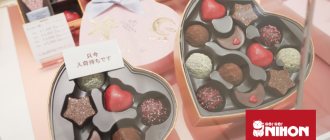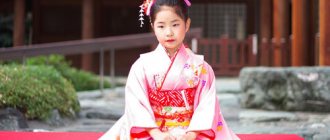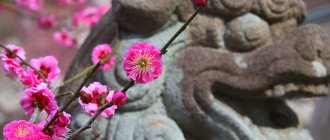The history of the translation of the phrase “I love you”
Natsume Soseki and Ftabatei Shimei, two names with which the history of the translation of the phrase “I love you” is associated. Before this, such a phrase did not exist in Japanese. Soseki, being an English teacher, translated this phrase from English. The background to this is that one of Soseki's students once translated the phrase "I love you" as 我君を愛す | utensils kimi o aisu (“I love you” - in Japanese). Soseki corrected the student that in Japan it is not customary to say 愛す | aisu (to love). Previously, it was not customary for the Japanese to express their feelings openly. He gave a more suitable translation, from his point of view: “(君と見ているから)月がきれいですね” (today (when you are with me) the moon is beautiful). This translation sounds more literary.
Another writer, Ftabatey Shimei, translated from Russian the phrase “I love you,” which was found in literary works of that time: “(あなたのためなら)死んでもいい” (for your sake) I can die. He, too, was looking for a suitable translation that would correspond to the indirect expression of feelings by the Japanese.
Also, instead of directly saying “I love you,” in Japan they often say “like you.” A sort of shyness of young people when expressing feelings. Despite the traditional indirectness of the Japanese in expressing their feelings in the past, the situation is now changing towards a more open and direct declaration of love, especially among young people. This is due to the significant penetration of Western culture into the land of the rising sun.
In order to understand how to say “I love you” in Japanese and to be correctly understood in our time, let's look at the options for hieroglyphs that mean the word “love”.
There are characters 愛(ai) and 恋(koi), as well as 好き(suki). What is the difference between them and how to use them?
好き(suki) is similar to the word “like”. What is meant here is not such a deep and serious feeling (like love), but a one-sided one, which arises for a certain time, is more an expression of passion, love. Quite often used in speech.
Ai
Well, the third word that we will consider is ai. Its meaning is love, but can be used not only to express strong romantic affection or platonic feelings. Of course, it can also be used to declare love. True, more often in such cases it is used in conjunction with the verb - aijo. In this version, the sentence will carry a semantic load associated with the concept of family love, platonic feelings and, of course, a very strong feeling - love. In this case, the combination “ai suru” is used.
So why, then, isn't the preferred phrase for declaring love "suki desu"?
This is because it is not used to express serious devotional feelings. It can be used to express feelings about a puppy, for example, or to say how much you love nature or vacations.
Ai suru is the first, but very significant step beyond friendship, indicating an emerging feeling of deep platonic love. As soon as people’s feelings move to a qualitatively new stage, close to the creation of a couple, “ai suru” can be used.
Language school students often make a mistake in using this word. So you need to remember, if you want to say “I love you” to someone, you need to change the verb “suru” to “shiteiru”. This change in the verb indicates that your feelings not only exist, but are getting stronger every day.
How to practically confess your love in Japanese?
If you have been interested in Japan before, you may have heard about Japanese “confessions” or kokuhaku 告白. Building a relationship begins with such a declaration of love to the person you like, followed by an offer to meet. Most often this involves the following words: 好きです。付き合ってください。 (Ski desu. Tsukiattekudasai.) - “I love you! Please, let's meet." You may have heard something similar in Japanese dramas.
If there was no such recognition, then it is not even considered that you are dating. But after kokuhaku, going on a date with another man (woman) is considered cheating. It is interesting that in Japan, a person often expresses a declaration of love to a member of the opposite sex even without having previously communicated with him. For example, a Japanese man can confess his love and propose to date a girl whom he only observed, but did not communicate with. This can often be seen in Japanese melodramas, which may seem quite unusual to us. After all, in our culture it is customary to confess your love to a person whom you have known for some time and with whom you have communicated.
And at the same time, when the Japanese start dating, they do not consider this a test of feelings, but take everything quite seriously, expecting to get married in the future. In this regard, they are quite traditional and official marriages are also supported at the state level.
Now you know how to say I love you in Japanese without being misunderstood.
If you plan to live in Japan, translate from Japanese, or gain a deeper understanding of the nuances of declaring love in Japanese, then learning Japanese is a must. To do this, it is better to attend Japanese language classes or courses.
Chinese character love
If you want to use this symbol as a Feng Shui sign, then in order for it to really begin to act and bring success in love affairs, it is better to write it yourself.
Description
The Chinese character for love contains four important elements that are required when applied. These are “roof”, “friend”, “heart”, “claw”. At first glance, a set of such words and symbols may not make any sense. But to understand it, you need to understand the deep meaning of Chinese philosophy and delve into the beauty of feelings. The hieroglyph needs to be deciphered like this: the lady must grab her claws right into the heart and completely envelop it with her attention and feelings. In this way, she becomes more than a friend.
Claw
Roof
Heart
Friend
The character Love 爱 in Chinese means not only love and affection for someone, but also an addiction to something (for example, an addiction to wine or I like to fish), to cherish and appreciate (for example, to value one's reputation), can also be used as an address (for example, my love).
If you apply the hieroglyph Love according to all the rules of Feng Shui, then it will only strengthen the bonds of love and marriage, protect the family from discord, conflicts, and reproaches. Loving people, using it, become closer, mutual happiness and love intensify. If you hang it in the right place in the house, love, peace, prosperity and harmony will reign in the family.
Writing rules
To write it yourself, you need to find an already depicted sign, take a good look and understand it - where, which of the indicated elements are depicted. The sign that will be used to attract harmony and feelings into the house must be perfectly executed, so it is better to stock up on several sheets of paper and practice. The original must be depicted using high-quality materials and on high-quality paper. For training, ordinary materials will be sufficient.
First, the sheet needs to be drawn into 10 identical squares. After this, draw each square into 4 more equal parts. It is in these cells that you need to draw each line of the sign step by step, one by one, in each cell to see whether every single detail has been depicted. It is recommended to start drawing the “love” sign from the top elements. The main thing is to practice and get good at it, look carefully, and don’t miss a single detail. If you are in a bad mood, it is better not to draw a sign. You only need positive thoughts that will charge the drawn hieroglyph with positive energy.
How to read
The Chinese character Love 爱 is pronounced ài [ai]. The phrase “I love you” – 我爱你 – is pronounced “wo ai ni”.
Chinese philosophy
Yin Yang – Yīnyáng – 阴阳. In Chinese philosophy, Yin and Yang (dark - light, negative - positive, masculine and feminine) describe how seemingly opposing forces can actually be complementary, interconnected and interdependent in the natural world, and how they can give rise to each other as they interact between themselves. Many material dualities (such as light and dark, fire and water, expansion and contraction) are seen as physical manifestations of duality.
Some of the Feng Shui tips are:
- Don’t get carried away too much and clutter the entire space with images of happiness and good luck; use no more than three positive hieroglyphs with different meanings in the corresponding areas of the house.
- If you want to give a gift to a loved one, then send your positive vibrations along with the talisman with a mental visualization of what you wish for him.
- Connect the meaning of the hieroglyphic symbol with the image and energy of the recipient.
What exactly makes the word “beautiful”?
Here are a few factors that transform a Japanese word from a communication tool into a work of art:
Japanese words sound smoothly, beautifully, like music. The Japanese language does not have tones, as in Chinese, but there is accentuation, which gives the words smoothness and movement. Russian has its own set of words that are simply pleasant to pronounce. For example, level, expressive, beloved. Something about certain words can make you feel a thrill, some can chill you to your very bones. Japanese words have a similar effect, even if you are not a native speaker.
Hieroglyphs, hiragana
and
katakana
are incredibly beautiful to read and write.
But some kanji
are especially beautiful when combined – it’s as if we are seeing an elegant design.
- A unique and beautiful meaning, not often found in European languages.
Add these beautiful words to your vocabulary, use them in everyday conversation, or just remember them. Beautiful Japanese words will serve you as a reminder of the beauty of the Japanese language.
Such different hieroglyphs: ideography
Hieroglyphs are not only Japanese and Chinese, there are also Egyptian, Arabic and Korean. It's kind of an elegant combination of painting and writing. It’s beautiful, but writing even a small text can take quite a long time if you do it by hand. As you know, hieroglyphs are not letters, but entire morphemes, words and even phrases.
Ideography (“writing an idea”) is a writing principle in which the unit of graphic designation is most often a whole word. It is from here that the development of writing originates. The most ancient are considered to be ancient Egyptian, Sumerian and Chinese. The first two are no longer used, but the Chinese honor the traditions of their ancestors and continue to use special characters as a modern means of writing.
Initially, hieroglyphs took the form of pictograms, simpler images of an everyday nature. However, not everything can be depicted with a picture. Difficulties arose when it was necessary to express abstract concepts in writing. For example, the symbol for “bao (guard)” is a combination of the characters for “man” and “child.”
LiveInternetLiveInternet
—Photo album
—Tags
-Music
—Categories
- Japanese (78)
- Quotes (73)
- Videos (70)
- This is funny ^^ (56)
- Photoshop (54)
- My Dog (40)
- Everything else ^^ (40)
- JE (39)
- Useful (37)
- Japan and everything connected with it (37)
- Recipes and cooking (29)
- FlashMobs (24)
- Smileys =) (22)
- Games and flash drives (17)
- Drawing lessons (14)
- Tests (14)
- College (13)
- My drawings (12)
- Drama (7)
- Photos (6)
- Watched/read lists (6)
- Pictures (6)
- IF ^^ (3)
- Baby rats (1)
- My dreams (0)









